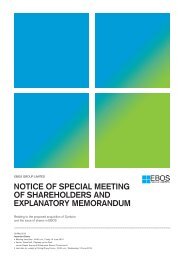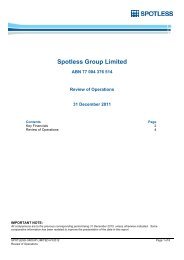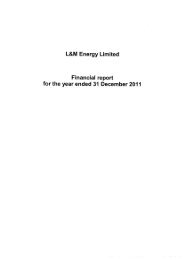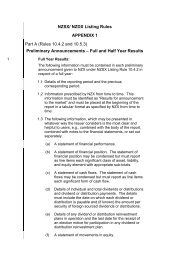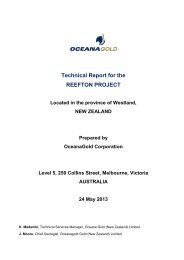Westpac Group Pillar 3 Report March 2013 - Iguana IR Sites
Westpac Group Pillar 3 Report March 2013 - Iguana IR Sites
Westpac Group Pillar 3 Report March 2013 - Iguana IR Sites
Create successful ePaper yourself
Turn your PDF publications into a flip-book with our unique Google optimized e-Paper software.
PILLAR 3 REPORT<br />
CREDIT RISK EXPOSURES<br />
Regulatory loss estimates and actual losses<br />
APS330 Table 6f compares regulatory downturn credit risk estimates used in the calculation of risk weighted<br />
assets to observed outcomes since accreditation.<br />
Predicted parameters represent average internally predicted long-run probabilities of default for non-defaulted<br />
obligors at the start of each year, as well as downturn estimates of loss (or the regulatory minimum where<br />
required). They are averaged using data from all the financial years beginning in 2008 and compared to observed<br />
outcomes over the same period 1 . Predicted parameters are established with reference to a full economic cycle,<br />
whereas this analysis covers a shorter period.<br />
Predicted parameters are updated annually and utilise observed outcomes from prior periods as a key input.<br />
In order to appropriately include the most recent half-year period, its outcomes have been annualised.<br />
Default rates<br />
The Predicted default rate is the average of all non-defaulted obligor probabilities of default at the start of the year<br />
averaged over the observation period. The Observed default rate is the actual default rate for each year, averaged<br />
over the observation period.<br />
Loss Given Default (LGD)<br />
The LGD analysis excludes recent defaults in order to allow sufficient time for the full workout of the facility and<br />
hence an accurate LGD to be determined. The workout period varies by portfolio: a two year workout period is<br />
assumed for transaction-managed and residential mortgage lending; and a one year period for other programmanaged<br />
portfolios.<br />
Exposure at Default (EAD)<br />
The EAD variance compares the observed EAD to the predicted EAD one year prior to default. For transactionmanaged<br />
portfolios, predicted EAD is currently mandated to be 100% of committed exposures. The observed EAD<br />
is averaged for all obligors that defaulted over the observation period.<br />
Where the value is negative it means that the observed EAD was lower than the initial predicted EAD, this could<br />
be because exposures were managed down prior to default or off-balance sheet items or undrawn limits were not<br />
fully drawn prior to default.<br />
Regulatory<br />
Default rate<br />
Loss Given Default<br />
Observed EAD<br />
variance to<br />
$m Expected Loss 2 Predicted Observed Predicted Observed Predicted 3<br />
Corporate 1,054 2.19% 1.32% 51% 40% (27%)<br />
Business lending 970 2.21% 1.62% 34% 21% (11%)<br />
Sovereign 3 0.26% - - - -<br />
Bank 14 0.45% - - - -<br />
Residential mortgages 856 0.68% 0.62% 20% 7% -<br />
Australian credit cards 291 1.31% 1.47% 76% 55% (3%)<br />
Other retail 409 4.69% 2.95% 71% 54% (3%)<br />
Small business 243 2.99% 1.91% 27% 16% (6%)<br />
Specialised lending 1,777 NA 2.67% NA 30% (7%)<br />
Securitisation NA NA NA NA NA NA<br />
Standardised NA NA NA NA NA NA<br />
Total 5,617 NA NA NA NA NA<br />
1 Predicted parameters are not available for specialised lending or standardised exposures because risk weights for these portfolios do not rely on credit<br />
estimates.<br />
2 Includes regulatory expected losses for defaulted and non-defaulted exposures.<br />
3 A negative outcome indicates observed EAD was lower than predicted EAD.<br />
49



